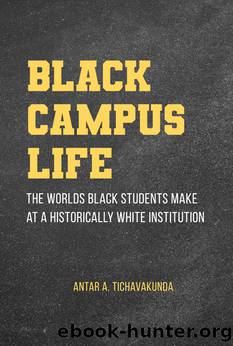Black Campus Life: The Worlds Black Students Make at a Historically White Institution by Antar A. Tichavakunda

Author:Antar A. Tichavakunda
Language: eng
Format: epub
Publisher: State University of New York Press
Published: 2021-09-15T00:00:00+00:00
One mode of connecting to discipline or majors is through engineering societies. Black studentsâ lack of involvement in such organizations, however, might be unsurprising if interactions between students at engineering society meetings are anything like interactions Black engineers often have with students in their classes.
Caldwell Organizational Involvement: In Summary
This chapter analyzes Black studentsâ experiences in Caldwell organizations and offices. Diversity and its tensions arose as a central theme. In studying engineering students, one must be careful to generalize experiences across engineering majors that may have vastly different cultures. Within engineering as a discipline and Caldwell as a school, students have diverse experiences depending on their major. Black Caldwell students also experience, understand, and navigate Caldwell in various ways. While students have varying perceptions of the racial climate in Caldwell, all students experience the reality of being part of a marginal Black population. By certain standards, Caldwell is racially diverse, especially compared to other engineering schools. Yet, Caldwell is not Black. Through diversity initiatives, Black studentsâ unique needs and Black student representation are occluded, exemplifying what I termed diversity dilution.
Student groups such as NSBE, SWE, or SHPE can serve as sites of study to better understand engineering studentsâ engagement across racial lines. In order to learn about specific student groups, scholars tend to construct student organizations as discrete objects (e.g., Guiffrida 2003; Museus 2008). Indeed, student organizations can be understood as social worlds of their own. But groups do not exist in isolation; they exist in relation to each other, creating a web of groups at the same university. Daisy Reyes (2018), for example, demonstrated how Latinx student organizations at the same campus vied for resources and how group cultures built identities in relation to other groups. Similarly, NSBE at WSU took its shape in relation to other organizations and was shaped by Caldwell as a social world. By examining the relationship between organizations one can see how groups potentially distanced themselves from NSBE or from Black students more broadly.
Concepts of student involvement and engagement provide entry points to understanding campus life (Astin 1984; Kuh 1995b). Further, student engagement opportunities are important to examine because they can result in positive educational outcomes (Pascarella and Terenzini 2005; Quaye et al. 2019). To think of student groups only in terms of transaction, or how involvement can be translated into positive educational outcomes, to be sure, is overly simplistic. Students might join a group to make friends, gain social status in a campus social world, party, develop a skill, get to know a crush, network, or to see people that look like them. It is worth noting, however, that some groups are more related to studentsâ career interests than others. Involvement in an engineering society, for example, can result in capital accumulation for students in the engineering career field in ways that involvement in NSBE or the Black Student Union cannot.
In their research on how college affects students, Pascarella and Terenzini (2005) suggest, âThe impact of college is largely determined by individual effort and involvement in the academic, interpersonal, and extracurricular offerings on a campusâ (602).
Download
This site does not store any files on its server. We only index and link to content provided by other sites. Please contact the content providers to delete copyright contents if any and email us, we'll remove relevant links or contents immediately.
Deep learning with TensorFlow and Keras by Derrick mwiti(865)
Understanding PDA Autism in Kids: A Guide for Parents and Teachers to Support Neurodiverse Learners by Jehu Len(713)
The Victorian Era: A Captivating Guide to the Life of Queen Victoria and an Era in the History of the United Kingdom Known for Its Hierarchy-Based Social Order by Captivating History(496)
Intersectionality in Educational Research by Dannielle Joy Davis; James L. Olive; Rachelle J. Brunn-Bevel; Susan R. Jones(477)
100 Ideas for Secondary Teachers: Engaging Parents by Janet Goodall & Kathryn Weston(475)
How to be assertive in any situation by Hadfield Sue & Hasson Gill(457)
Writing Solid Code: Development Philosophies for Writing Bug-Free Programs by Steve Maguire(457)
Brain Teasers to Build Critical Thinking Skills: Brain Exercises for Tech, Banking, Case Interview Prep, and to Keep Your Mind Sharp by Kris Safarova(449)
Brain Teasers to Build Critical Thinking Skills by Safarova Kris(448)
Python 101 - Fundamentals by Sam(411)
Critical Curriculum Leadership : A Framework for Progressive Education by Rose M. Ylimaki(407)
The Art of Emotional Validation: Improve Your Communication Skills and Transform Your Relationships by Validating Emotions and Feelings by Emily Wright(376)
The Knights Templar: An Enthralling History of the Rise and Fall of the Most Influential Catholic Military Order by Wellman Billy(367)
The Future Knowledge Compendium by Ellyard Peter;(364)
A Beginner's Guide to SSD Firmware by Unknown(362)
What Every Teacher Should Know about Learning, Memory, and the Brain by Tileston Donna E. Walker;(360)
NumPy : From Basic to Advance by bisht Karan Singh(348)
Making Connections in and Through Arts-Based Educational Research by Hala Mreiwed Mindy R. Carter Sara Hashem Candace H. Blake-Amarante(342)
Foundations of Educational Research by Victoria Elliott(335)
